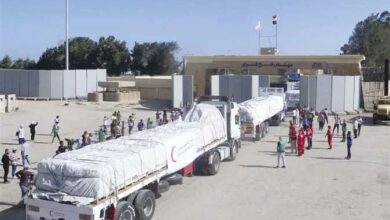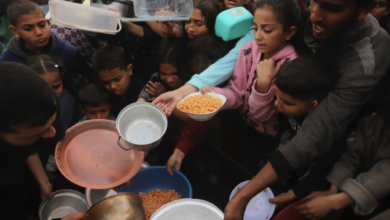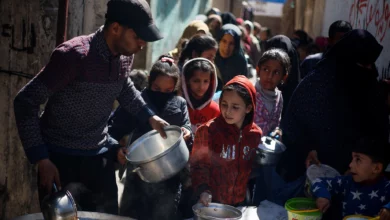DADAAB, KENYA – When volunteers arrive at the Dabaab refugee camp on the Kenya-Somalia border, many believe they are coming to help Somalis suffering from the severe food shortage currently ravaging the horn of Africa. They are half right.
In fact, the camps in this border area are mostly well-established and house hundreds of thousands of refugees from a series of catastrophes, natural and man-made, over the past few decades. Now absorbing new waves of famine victims, these make-shift towns are testimony to Somalia’s troubled recent history, plagued by an unfortunate mixture of crippling civil wars and an inability to deal with natural disasters.
With no permission to enter Kenya proper, and little chance of a secure life back in Somalia, many refugees have opted for a semi-permanent existence in the border camps, relying on hands-outs and unable to invest in any kind of independent life. And the camps keep growing.
Approximately 1200 refugees arrive at the UNHCR reception center in Dabaab daily, hungry, exhausted and happy to be out of Somalia. But those escaping the drought-induced famine, which the United Nations says could leave around 750,000 Somalis at risk of starvation, are joining an established refugee camp with a population of 440,000 that dates back 20 years.
Dadaab lies in the sparse desert expanse of northeast Kenya, only eight hours by car from the capital Nairobi, which is humid, green and at an elevation of 1600 meters. Dagahley, one of the three main camps in Dadaab, starts out looking like a bustling, albeit destitute rural city, with clusters of tin-roofed shacks, and even a small marketplace.
After a labyrinth of small mud-houses, and the walled-off NGO headquarters, the tent-city of newcomers becomes visible, and the first glimpses of real tragedy begin to reveal themselves. This is where the semi-stable demeanor of the veteran camp dwellers gives way to the struggling and tentative demeanor of recent arrivals.
“I know there’s food here, but more importantly, it’s safe,” said Abdel Qader, upon his arrival from a month-long journey on foot from southern Somalia with his wife and three children.
“The political situation is making it very difficult to get any aid into Somalia, where the biggest tragedy is taking place and where the drought is at its worst,” said Shams, a Kenyan aid worker of Somali decent.
The message from many of the Somali refugees and in the camps was summarized simply by one woman, Amina, who had just arrived with her baby child from south Somalia: “It is like hell, over there now. Famine on one side, and the politics on the other.”
The tragic situation of these new arrivals hit by natural disaster and persecution, contrasts with the simmering despair of older residents. They all rely on handouts, because like any refugees around the world, they’re stuck.
Providing assistance to the camp’s residents is a tremendous undertaking that involves the work of a handful of permanent – and many more transient – relief organizations. UNHCR and the international humanitarian group CARE dominate the relief work in Dadaab, but many independent groups also coordinate with some local groups.
The Kenya Youth for Development (KYD) group, for example, provides a safe haven for some relief teams, with its fenced-off awning in the middle of the new section, and also helps other independent groups distributing aid within the camps. An Indonesian development organization called ACT has used the premises of the KYD to provide vaccinations for a variety of diseases, including cholera and measles.
“The presence of these local premises allows us much-needed protection, and the ability to be organized, which would otherwise not be possible without a permanent base here,” said Kolo Yousef of ACT.
Outside the KYD's area, dozens of refugees wait, hoping for handouts in a section of ground reserved for newcomers. Around 100,000 newcomers have arrived in the camps since the drought started last summer, and while the UNHCR clamors to accommodate them in a timely manner, there is a clear need for better infrastructure in the temporary areas.
CARE is in the process of providing cisterns of water and water pumps, but more is needed. “We just received this water pump 10 days ago. Before then, many more children were dying every week than now,” said Abdel Haq, a resident of the Dagahaley camps for two months now.
“Those who need to do good here, need to just pick their cause, the area [in the camps] they will do it in, and just do it without thinking. Everyone here is in need one way or another,” said Zakir Usman, who worked in the Ifo camp area in Dadaab, organizing the distribution of food for a UK-based charity.
The distribution zone at the Ifo camp is one of just a few established and secure zones, and is within walking distance of the old camp dwellings. Still, it’s far enough that new arrivals have to walk for hours to this area in order to receive the aid.
The banner accompanying Usman’s food shipment reads: “Relief for the famine in Somalia.” However, many of those receiving the food are not victims of the current famine, but refugees that have arrived at various times over the past 20 years, when the camps first opened, according to Zakir. Many of those registered and established refugees receive food rations from UNHCR or CARE, and most seem to get by on what they are given.
“The UNHCR food rations are appropriate for the needs of the camps,” said Emily Castaignet, a regional coordinator for Medicins Sans Frontiers (MSF).
The rations, while perhaps appropriate, underline a major problem for the 20-year-old camps, an entire populace and generation raised with very little knowledge about self-sustenance.
“Most people in the camp rely on charity for food. They have nowhere else to get it from,” said Ali Hassan, who arrived in Dadaab as a three-year-old child in 1991.
Ali now runs a shop that makes and sells furniture within the camps. Having worked since he was 15 selling whatever he can in the camps’ market place, he is one of the few refugees able to make an honest living and even amass some savings.
“Unfortunately, I can’t go buy the wood from Nairobi. I have to have it delivered. I was never able to learn the craft, so I also have to send for workers,” he said. As a refugee, he was never able to obtain permission to leave the camps and enter the rest of Kenya.
Someone like Ali has two options: Go back east to his homeland and face drought and the ruling hard-line Islamist group Shabaab al-Mujahideen, or hope that someday he will win the lottery and be able to go to the US or Europe.
“Almost everyone here is hanging onto the hope that someday they’ll win the visa to America. We all know of people who have. They live very well there,” he says.
Ali’s real dream was to continue his studies. Many like Ali grew up going to schools run by CARE. For all the residents in the camps, though, there isn’t one post-secondary educational institution.
Just as he relied on CARE for education, he relied on MSF for medical care. Just as he would never be able to go to university as a Dadaab resident, he would also not be able to go to a hospital if inflicted with a chronic disease.
“Official medical aid workers provide an adequate amount of doctors and beds in our hospitals. But people have great expectations of us; we cannot deal with major illnesses,” said Cataignet. MSF tries to refer chronic illnesses to hospitals outside Dadaab. However, many residents find it very difficult to reach a point where they are able to get the referral and have it approved on time.
While Castaignet acknowledges that there is a significant fear of a cholera outbreak in Daadab when the rains fall – which should be soon – she says MSF and others working in the camps are equipped to deal with it.
Still, with all of the camps' problems, most agree that returning to Somalia now is not an option.
“There are really bad problems here, but in the end, we eat. Some people in Somalia have nowhere to go,” said Ali Adan, a 55-year-old camp resident. “Our family, who are stuck in Somalia, are suffering more than us.”



